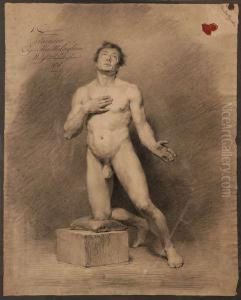Eugene Romain Van Maldeghem Paintings
Eugène Romain Van Maldeghem was a 19th-century Belgian painter known for his landscape and architectural works. Born on April 14, 1813, in Ghent, Belgium, Van Maldeghem developed an interest in art at a young age. Belgium at the time was experiencing a period of artistic flourishing, with various movements influencing the artistic scene.
Van Maldeghem initially studied architecture, which greatly influenced his later painting style. His architectural background is evident in the precise and detailed way he rendered buildings and structures in his compositions. However, his primary passion was painting, and he pursued this with a focus on landscapes and cityscapes. He was particularly adept at capturing the play of light and shadow, which added a dramatic effect to his works.
Throughout his career, Van Maldeghem exhibited his works in various salons and exhibitions, gaining recognition for his unique style that blended architectural precision with the romantic sensibilities of the time. His landscapes often featured rural scenes, historic buildings, and occasionally figures, although the latter were not the main focus of his work.
Eugene Romain Van Maldeghem remained active in the Belgian art scene throughout his life. His contributions to landscape and architectural painting were appreciated by his contemporaries, and he played a role in the development of these genres in Belgium. Sadly, his life and career were cut short when he passed away on December 17, 1867, in his birth city of Ghent.
Although he may not be as widely known as some of his contemporaries, Van Maldeghem's work is still of historical interest, particularly for those studying the evolution of landscape and architectural painting in 19th-century Belgium. His paintings are characterized by a keen attention to detail and a mastery of atmospheric effects, which continue to captivate viewers to this day.








